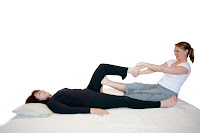Look out for parts 2 (during massage) and 3 (after massage) over the next few weeks. And if you have pressing questions I've missed (I'm sure there are loads) leave a comment, e-mail or text me; you could be the start of Part 4.
How should I prepare before a massage?
There are a number of things you can do to make sure you get the best from your experience.
Think about why you are having the massage and what you want to get out of it. You are then in a position to clearly communicate this to your massage therapist, so they can try to meet your expectations (within reason of course!) It also allows you to better assess at the end whether the treatment was beneficial.
Try to leave plenty of time for your massage, so you are not rushing to get there, and arrive relatively calm (especially if you are having a relaxing treatment). This also ensures you don’t miss out on treatment time through being late. If you are going to a new location, make sure you know the way, and where to park, again to avoid any unnecessary hassle before the treatment.
It’s better not to eat in the hour before massage, and not to have a large meal for 2 hours beforehand. Also avoid drugs or alcohol, and stimulants like caffeine. Make sure you are clean and fresh – if you’ve been exercising, have a shower before going for a massage. If you’re having a facial massage remove heavy make up – you may also want to do this if you’re going to have your face in a face ring (for a back massage for example).
See also the question below on what to wear for massage.
What sort of massage should I choose?
That depends! Think about what you want from a massage, or don’t want. Then do a little bit of research – speak to friends who have massage, and to therapists you know, or think you might want to visit. There is a lot of information on the internet, both on the pages of therapists offering the treatments, and more general information pages such as this.
 |
| Choose a massage that appeals to you |
In general, chose an option that meets any specific needs and that appeals to you – you’re less much likely to benefit from a treatment you think sounds “weird” or is more intrusive than you’re comfortable with. Of course practical factors like availability in your area and price also come into the decision.
Often the best way is through recommendations or referrals, either from friends or from other health care or complementary providers you may be seeing. If this is not possible, search online, in local directories, or look for cards and leaflets in clinics or health care centres near you.
Some things to look out for are firstly, their training – are they qualified in the services they offer? Secondly, are they insured – this shows a professional approach, and protects you and them in the unlikely event something happens. Ask to see certificates for training and insurance if these are not on display. Thirdly, are they a member of a Professional Association? This will mean they abide by a code of ethics, and carry out on-going development to keep their skills up to date.
What should I wear?
This depends on the type of massage you are having.
For oil massage, you will remove clothing (but not underwear) on the areas being massaged, so it doesn’t matter that much, although things that are easy to take on and off are helpful. If your back is being massaged, but not gluteals (buttocks) or legs, a loose waistband means you can keep your trousers/skirt on, but jeans or other inflexible trousers/skirts would probably still need to be removed to give access to the lower back. “Sensible” underwear is helpful – by this we mean something sturdy enough that we can tuck a towel into them, to hold the towel in place and avoid oil getting onto the underwear. For a back massage a back opening bra is needed, so the therapist can undo it for the back massage (otherwise the bra has to be removed).
Thai Massage is performed clothed, so wear clothes you can move easily in, like you would wear for yoga. The therapist will usually have loose clothes available if needed. The same applies for Pulsing. If you are having a Thai compress, with your Thai massage, clothes will be provided as the compress can stain. For a Thai Compress on its own you will remove clothes (but not underwear) as for an oil massage, and towels are used to cover the areas not being massaged. For a Thai Foot Massage, the therapist needs access to your feet and legs up to and above the knee, so trousers, if worn, need to be very loose to roll right up so they don’t get in the way, or get cream on them. Shorts are preferable, and can often be provided, or trousers can be removed and a towel used to cover your lap.
Indian Head Massage and other seated massages do not require any clothing to be removed, or any specific clothing. A single layer is preferred, and avoid roll necks or cowl necks that might make it harder to get to the neck. Some people suggest a vest top, but I find that working on a mixture of cloth and skin is harder so prefer a top that covers the back.
I’m uncomfortable about undressing in front of a stranger – does that mean I can’t have massage?
The short answer is – no. There are lots of options for massage without removing clothing.
I’ll say first of all that you should never be asked to undress with someone watching – the therapist will either leave the room, giving you a gown to put on, or a towel or blanket to cover yourself on the couch when you’re ready, or hold a towel or other screen up between you, which they lay over you on the couch without looking.
Indian Head Massage, seated massage, Thai Massage and Pulsing are all options that are performed clothed. You can also have oil massage, for example on the hands, face and scalp, or feet if you’re happy to remove your shoes and socks.
Over time, as you build up a relationship with your therapist, they may feel like less of a stranger. If you want to expand your massage experience, discuss the options with them. For example, you could have a short leg massage whilst wearing shorts. You always have control over what happens in the massage room. It’s almost impossible to give an effective massage with a client who’s uncomfortable, so your therapist will fully respect your choices and work within the boundaries you set.
What should I bring with me?
There isn’t usually anything you need to bring, except of course payment. If you have long hair which may need to be tied up, a hair band or clip is useful. For some massages loose clothes you can move in are needed (see “What should I wear?” above); if you are coming from work, for example, you may need to bring these to change into.
Can I bring my own oil?
Most therapists have a preferred oil that they like to work with and which suits their style of massage. In cases of allergies or reactions, or if you really don’t like their oil, they should have an alternative available.
 |
| Most therapists have oils they prefer to use |
Blended oils, containing essential oils or other additives, are a different matter. Unless therapists are trained in aromatherapy, they will not be able to use essential oils at all, as this would be stepping outside of their area of expertise (in the same way that you wouldn’t expect them to provide reflexology or sports massage if they weren’t trained in it).
Aromatherapists will also usually refuse to use oils they have not provided, as they do not know the origin and quality of the oils. This may sound judgemental, but is aimed at protecting you, as well as their reputation, if the oils aren’t what they should be. Of course, if you like essential oils for your massage, an aromatherapist is the person to talk to.
I’m a bit nervous, what will help?
It’s easy for me to say, there’s no need to be nervous, but of course if massage is something new, or outside your comfort zone, it’s natural to be a bit apprehensive.
Firstly, let your therapist know. You may wish to speak to them on the phone before your appointment. Ask about what will happen at the appointment – knowing what to expect can put your mind at rest. If there is a particular aspect that’s bothering you, like a painful experience with massage in the past, or a part of your body you’re uncomfortable with, there are ways to accommodate this, such as starting with a gentle massage, or not exposing that area until you feel ready.
Remember that at all times during your appointment, you are in control. You can stop the massage, have a break, change the pressure or move to a different area at any point. Sometimes verbal communication is difficult, either because you are face down, or because you are relaxed and sleepy, in which case agree a hand signal with your therapist to let them know when you want a pause. The therapist is there to serve you, and the most important thing is that you have a positive experience.
How long will the massage last?
This will in part depend on what you book. Massages are usually quoted by time (e.g. One hour deep tissue massage…. £45) or state the time (e.g. Full body relaxing massage (90 minutes)….. £60). If this is not the case, ask.
You should also check the terms for the particular therapist – if they book clients every hour, your one hour massage will include time for the consultation, undressing, and redressing at the end, as well as preparing the room for the next client, so you will be on the couch for maybe 50 minutes. Some therapists will allow extra time for the consultation on the first visit in addition to the quoted time. Other therapists will massage for the time quoted, so consultation, changing and turn around times are in addition to the massage time quoted. This is particularly important to know if you have to be somewhere after the massage – it’s best to advise the therapist if this is the case. They can then worry about that, and you get to relax and enjoy the massage.
Will massage hurt?
 |
| Deep tissue massage - sometimes a gentler approach is what your body needs |

No comments:
Post a Comment